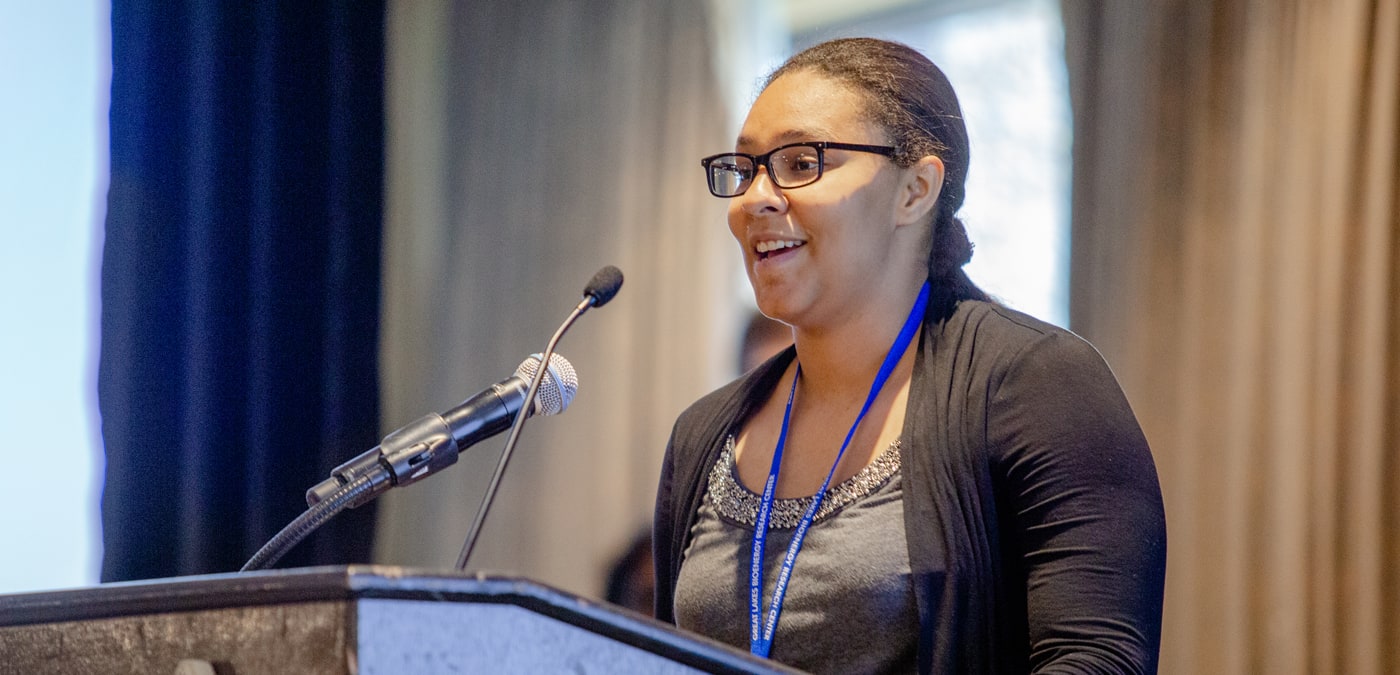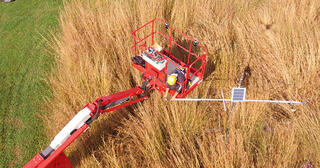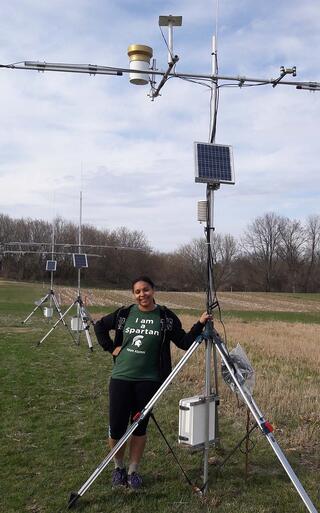
To Cheyenne Lei, a Ph.D. student in the landscape ecology and ecosystem science lab at Michigan State University (MSU), geography can mean dabbling in remote sensing, satellite imagery, hydrology, or even volcanic eruptions. Lei uses this broad curiosity at the Great Lakes Bioenergy Research Center (GLBRC) to study how land in the Midwest accommodates the sun’s rays, a phenomenon called “albedo.” The interactions between solar radiation and the makeup of our agricultural landscapes are at the core of Lei's work.
Imagine a snowy field in early spring. Climatic conditions resulting in low albedo and high absorption of radiation lead to faster melting snow. In the short term, lower albedo means a quicker thaw. It also could equate to more heat trapped in the atmosphere over the long term, leading to an acceleration of Earth’s changing climate.
“There are a lot of factors that affect the albedo of crops,” says Lei. “Temporal variability such as growing season versus winter, soil moisture, especially when the soil is really wet or dry, the height of plants, how much leaf canopy there is during a growing season, and even nitrogen content, temperature and cloudiness can affect how much sunlight is absorbed or reflected.”
Examining years of data at GLBRC’s cropping systems trials at MSU’s Kellogg Biological Station in Hickory Corners, Mich., Lei compares albedo on lands cultivated with bioenergy crops including switchgrass to traditional corn fields and prairie systems.
Lei spoke to us about how albedo is linked to soil health, growing seasons, and our climate, as well as her own journey into the broad field of geography.

How did geography become your passion?
Back in high school, I found that spark while reading a book on the volcanic eruption of Mount St. Helens. I kept reading on the ecological solutions – both manmade and natural – that came together to create a totally different environment, and I found that geography was something I really wanted to study.
For my undergrad at Northern Michigan University, I experimented in many types of geography and I definitely found myself to be more of a physical geographer. From there, I always enjoyed geology and hydrology, and just branched out from there.
While completing my Masters at Western Michigan University, I did a lot of remote sensing and hydrology. I focused more on satellite imagery, and how we can view temporal and spatial changes of water patterns and flooding within very urbanized rivers such as the Huron River in Southeast Michigan.
Why study things like solar radiation and albedo?
If we're trying to cool the atmosphere and mitigate carbon emissions, we want our radiation to not be absorbed into the ground, but instead reflect off of the canopy back into the atmosphere. But on the flip side, farmers who may want to plant two sets of corn or soybean crops in one season may want to warm the surface slightly quicker by planting cover crops that have both positive and negative implications, including winter warming. Thus, understanding the fine line between sustainability and agricultural management is important in mitigating climate change.
Tell us about your research into root systems at GLBRC.
When I first started my Ph.D., my advisor, Jiquan Chen, asked me to assist in some research looking at root systems as a way to get introduced to the field sites and the other students at Kellogg Biological Station. It was also a chance to use my GIS [geographic information system] and remote sensing background in a new way.
Past research at the GLBRC biofuel cropping system experiment sites had shown what happens to roots in the soil when you change the landscape from soybean to prairie, or soybean to other agricultural land. We wanted to create a synopsis of what happened in the last eight years since they’ve been converted to a different type of crop.

The reference site, which was just a grassland, had the most root biomass for the entire study period because it was never harvested, followed by Conservation Reserve Program grasslands, prairie, switchgrass, and corn sites. Interestingly, switchgrass roots established a year earlier than prairie, which took a little longer for roots to establish. The prairie also was very diverse when it was first converted, but it was very interesting to see how some species dominated over others in the long term.
You have also done some teaching - how do you see your career evolving?
I have had the opportunity to intern at various watershed councils across Michigan, help teach an ecology course at the Kellogg Biological Station, and have managed more than eight interns in the past five years. I applied my experiences not just in the classroom, but outside the classroom, too. This took various forms: Sometimes that meant going into the streams and to take micro-invertebrate assessments or to test water quality, or taking solar radiation measurements in different areas. Sometimes just meant going for a nice walk in waders, because it was a great day outside to look at the landscape or check out the Kellogg dairy farm establishment. Whether it was tinkering with large datasets, or hands on experiences in the field, I took each unique moment and crafted them into learning experiences.
In five years, I’d like to see myself in a tenure track position at a research-heavy university, working my way to having my own lab, where I can follow in my advisor’s footsteps doing research and providing opportunities for undergraduates to expand their careers. Being that geography is extremely interdisciplinary, I would be ecstatic to continue paving the way for groundbreaking research in atmospheric physics: analyzing albedo, global warming and climate impacts of different landscapes – from ecological to forest, to urban, even branching into volcanic landscapes which cover large regions of the U.S.